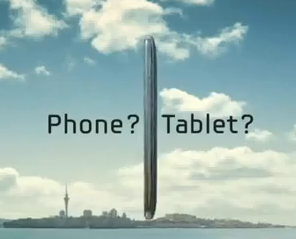The “Phablets” Are Coming — Please Make It Stop
Galloping into the annals of bad portmanteaus comes the word “phablet.” This is the would-be combination of phone and tablet, as you might have expected. It’s being used to describe devices larger than the largest Android smartphones (4.8 inches) but smaller than 7-inch tablets. The Galaxy Note is the exemplar of this new category (if […]
 Galloping into the annals of bad portmanteaus comes the word “phablet.” This is the would-be combination of phone and tablet, as you might have expected. It’s being used to describe devices larger than the largest Android smartphones (4.8 inches) but smaller than 7-inch tablets. The Galaxy Note is the exemplar of this new category (if we want to dignify it as a separate category).
Galloping into the annals of bad portmanteaus comes the word “phablet.” This is the would-be combination of phone and tablet, as you might have expected. It’s being used to describe devices larger than the largest Android smartphones (4.8 inches) but smaller than 7-inch tablets. The Galaxy Note is the exemplar of this new category (if we want to dignify it as a separate category).
Online market research provider uSamp recently conducted an online survey (n=400 US adults) about “phablet” awareness. Not surprisingly it found low awareness of the term but some level of consumer interest:
- 87 percent of those surveyed had never heard of phablets
- 33 percent of respondents would be likely to purchase a phablet after learning what it is
- 33 percent listed price as the main motivation to switch from a smartphone to a phablet
While the development of yet another interim screen size (along a continuum) is interesting the term “phablet” is just ridiculous. Some terms and concepts must be strangled in their cribs. This is one of them. We should not — under any circumstances — legitimize and accept this word.
It remains to be seen how many other device makers (beyond Samsung) move in to this super-sized smartphone category. The Galaxy Note was something of a surprise hit for Samsung and now the Galaxy Note II (or Galaxy Note ¡Dos!, as I like to call it) is about the hit the market. If it also sells well I suspect LG, Motorola and others will follow with giant-screened Android smartphones.
We now have 4-inch plus smartphones, 7-inch tablets, 10-inch tablets and this new in-between 5- to 6-inch screen size. If this fourth screen size takes hold it becomes a kind of slam-dunk argument for responsive web design. Ad formatting is more problematic unless there’s a RWD equivalent developed for ads (perhaps it exists unbeknownst to me). Doesn’t optimizing apps for all these varying screen sizes become a challenge as well?
By Thanksgiving the market will be awash in shiny new gadgets: the anticipated iPad Mini, a new 10-inch Nexus tablet, Kindle Fires and so on. Consumers may become seized by a kind of mobile device mania as a result. Let us pray however that they don’t head into electronics retailers asking to see the newest “phablet.”
Contributing authors are invited to create content for MarTech and are chosen for their expertise and contribution to the martech community. Our contributors work under the oversight of the editorial staff and contributions are checked for quality and relevance to our readers. MarTech is owned by Semrush. Contributor was not asked to make any direct or indirect mentions of Semrush. The opinions they express are their own.
Related stories